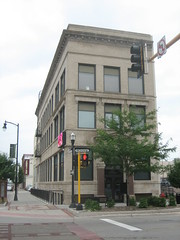Last weekend (August 8-11) I traveled to Fargo, North Dakota, for my friend’s wedding. I attended my first year of college at North Dakota State in Fargo from 2005 to 2006, so it was nice to get back and see my old friends and the city that was my first home away from home. I was sure to make time to look around a bit and see what has changed. The city was just as I remembered it, but I quickly realized the character and qualities of Fargo that I had come to admire, especially in the older neighborhoods and downtown. It was sort of like coming home.
Fargo’s older areas – within a mile or two radius of downtown – have aged nicely. Matured tree canopies have formed over residential streets, turning these axes of movement into spaces of their own. Mostly modest homes are well maintained. Residential streets flow harmoniously into downtown – with large yet unintrusive MeritCare hospital on the north end and beautifully simple Island Park to the south. There are no significant physical or psychological barriers surrounding downtown so there is good pedestrian connectivity between downtown and nearby neighborhoods.
I visited downtown briefly the morning before I left town. I parked on the north end of Broadway near the old Great Northern depot and walked down to the GTC and then stopped by NDSU Downtown. Walking down the sidewalk I could sense the liveliness around me. Despite massive suburban growth out west and south, downtown is still successful and retains the community’s heart.
 Two years ago I scoffed off Fargo’s downtown as minimal or less impressive than that of my hometown Cedar Rapids simply because it had less of a “big city” feel – and big city skyline – that I perceived back home. Of course now I realize human scale design, pedestrian-friendliness, and 24-7 vibrancy are the traits actually good urban downtowns, not superficial towers that likely contribute little to sidewalk activity. Even before the flood that devoured Cedar Rapids’ downtown, I believe Fargo’s downtown is still a more dynamic city center. While downtown Cedar Rapids is/was certainly a bigger employment center, most of those jobs are in the 9-5 office crowd. Fargo’s downtown seems to be much more diverse with a more significant retail and restaurant scene. They also didn’t tear down as many of their older buildings that give downtowns their historic character and human-scale.
Two years ago I scoffed off Fargo’s downtown as minimal or less impressive than that of my hometown Cedar Rapids simply because it had less of a “big city” feel – and big city skyline – that I perceived back home. Of course now I realize human scale design, pedestrian-friendliness, and 24-7 vibrancy are the traits actually good urban downtowns, not superficial towers that likely contribute little to sidewalk activity. Even before the flood that devoured Cedar Rapids’ downtown, I believe Fargo’s downtown is still a more dynamic city center. While downtown Cedar Rapids is/was certainly a bigger employment center, most of those jobs are in the 9-5 office crowd. Fargo’s downtown seems to be much more diverse with a more significant retail and restaurant scene. They also didn’t tear down as many of their older buildings that give downtowns their historic character and human-scale.
Away from downtown and the older neighborhoods, Fargo is booming to the south and west, furthering suburban sprawl far out in to the plains. 13th Ave S, west of I-29, and extending into the city limits of West Fargo is the metro’s principle shopping corridor. It is big box central, a landscape of asphalt and low rise retailers. For over two miles, the roadway is characterized by heavy traffic, cheap buildings, and very few trees. I actually didn’t go down the whole way while I was there, but my guess is that much has remained the same.
There are signs of some more urban-minded development on the outskirts, like Woodhaven Plaza at 40th Ave S and 42nd Street S, a three-story, mixed facade building with commercial space and upper residential units for sale. Somewhat awkwardly, an enclosed glass walkway is juxtaposed against the front of the ground level storefronts, for the winter months. Even though this development is an improvement over the monotonous strip mall or big box, it is still includes a sea of parking, is not built up to the sidewalk, and is surrounded by typical suburban subdivisions. So while these developments make an effort to be more urban and amenable to pedestrians, the fact is most people will still arrive by car because it is still more convenient than alternative modes.
All in all I had a good time on my visit to Fargo. Its a nice community that I enjoyed being a part of. Read more about NDSU and Metro Area Transit in my following posts.

